Biography
Born in a cabin without electricity in the remote mountains of northern California, Levi Hammett developed a deep interest in geographic space together with the concept and process of location. Raised in a blue collar family he worked as a sign painter and carpenter before pursuing a formal education in design focusing on coding and automation. This background developed into a creative practice that uses computational processes to inform the creation of hybrid design objects incorporating digital technologies that are rooted in traditions of craft.
His work includes a series of hand-made Islamic carpets that explore the urban culture of the Arabian Peninsula, a kinetic installation using 40 printers suspended from the ceiling outputting typography and imagery scraped from the web, and a series of digital displays imagining alternative histories of Arabic typography.
His work includes a series of hand-made Islamic carpets that explore the urban culture of the Arabian Peninsula, a kinetic installation using 40 printers suspended from the ceiling outputting typography and imagery scraped from the web, and a series of digital displays imagining alternative histories of Arabic typography.
His work has been acquired by several notable individuals and institutions, including the private collection of Her Excellency Sheikha Al Mayassa bint Hamad bin Khalifa Al Thani. His work has been published in print and online collections, distributed as digital applications, and exhibited in Asia, Europe, the Middle-East, South America, and the United States.
In 2019 Levi co-founded xLab,1 a non-hierarchical research & development studio working to produce electronic art, curricula, and hardware+software based tools to extend creative practice. Levi Hammett received his MFA in Graphic Design from the Rhode Island School of Design in 2006.2 Currently, he is an Associate Professor and Inaugural Director of Kinetic Imaging at Virginia Commonwealth University School of the Arts in Qatar where he teaches a range of classes which explore computational art, the design of graphic products, and culturally constructive design.
In 2019 Levi co-founded xLab,1 a non-hierarchical research & development studio working to produce electronic art, curricula, and hardware+software based tools to extend creative practice. Levi Hammett received his MFA in Graphic Design from the Rhode Island School of Design in 2006.2 Currently, he is an Associate Professor and Inaugural Director of Kinetic Imaging at Virginia Commonwealth University School of the Arts in Qatar where he teaches a range of classes which explore computational art, the design of graphic products, and culturally constructive design.
1. Hammett, Levi., et. al. xLab (studio for) {new = making + computation}. Funded by the Institute for Creative Research, VCUarts Qatar, Doha, Qatar. 2019. link
2. Hammett, Levi. Deliberate removal : creating space for participation. 2006. 224 pages : illus. (chiefly color) ; 22 cm. GRAPH 2006 .H36
2. Hammett, Levi. Deliberate removal : creating space for participation. 2006. 224 pages : illus. (chiefly color) ; 22 cm. GRAPH 2006 .H36
Street Scanner
The omnipresence of machine vision in our daily lives is subtly reshaping how we perceive the world. Cameras, sensors, and algorithms now weave a complex digital web, translating our reality into a series of virtual constructs. Street Scanner, a new interactive installation hosted by the jewelry brand Januka in central Tokyo, invites passersby to engage with and explore the captivating and, at times, unsettling aesthetics generated by machine vision. Utilizing readily available hardware and software, the artwork challenges visitors to critically reflect on the pervasive influence of digital perception in shaping our understanding of the world.
Created by Hala Amer, Saga Elkabbash, Levi Hammet, Giovanni Innella, and Martin Basalan Juras, Street Scanner is part of the prestigious Tokyo Designart Festival. Positioned prominently on Januka’s storefront, it allows the public to interact with the machine-driven visuals, engaging them directly in a conversation about the pervasive nature of machine vision. This immersive experience brings the invisible gaze of technology into public view, encouraging a deeper examination of its impact on daily life.
As part of the installation, a set of electronic jewelry designed by VCUarts Qatar alumna Hind Al Saad will be showcased. The pieces reinterpret the modular structures of printed circuit boards into contemporary Islamic patterns, exploring the intersection of computation, Islamic art, and intricate jewelry design.
As part of the installation, a set of electronic jewelry designed by VCUarts Qatar alumna Hind Al Saad will be showcased. The pieces reinterpret the modular structures of printed circuit boards into contemporary Islamic patterns, exploring the intersection of computation, Islamic art, and intricate jewelry design.
Exhibitions & Publications:
Street Scanner. Design Art Tokyo. Januka. Tokyo, Japan. (Solo Exhibition). 18 - 27 October 2024.
Street Scanner. Design Art Tokyo. Januka. Tokyo, Japan. (Solo Exhibition). 18 - 27 October 2024.
Hala Amer
Saga Elkabbash
Levi Hammett
Giovanni Innella
Martin Juras
Hind Al Saad
Levi Hammett
Giovanni Innella
Martin Juras
Hind Al Saad
Future Memories
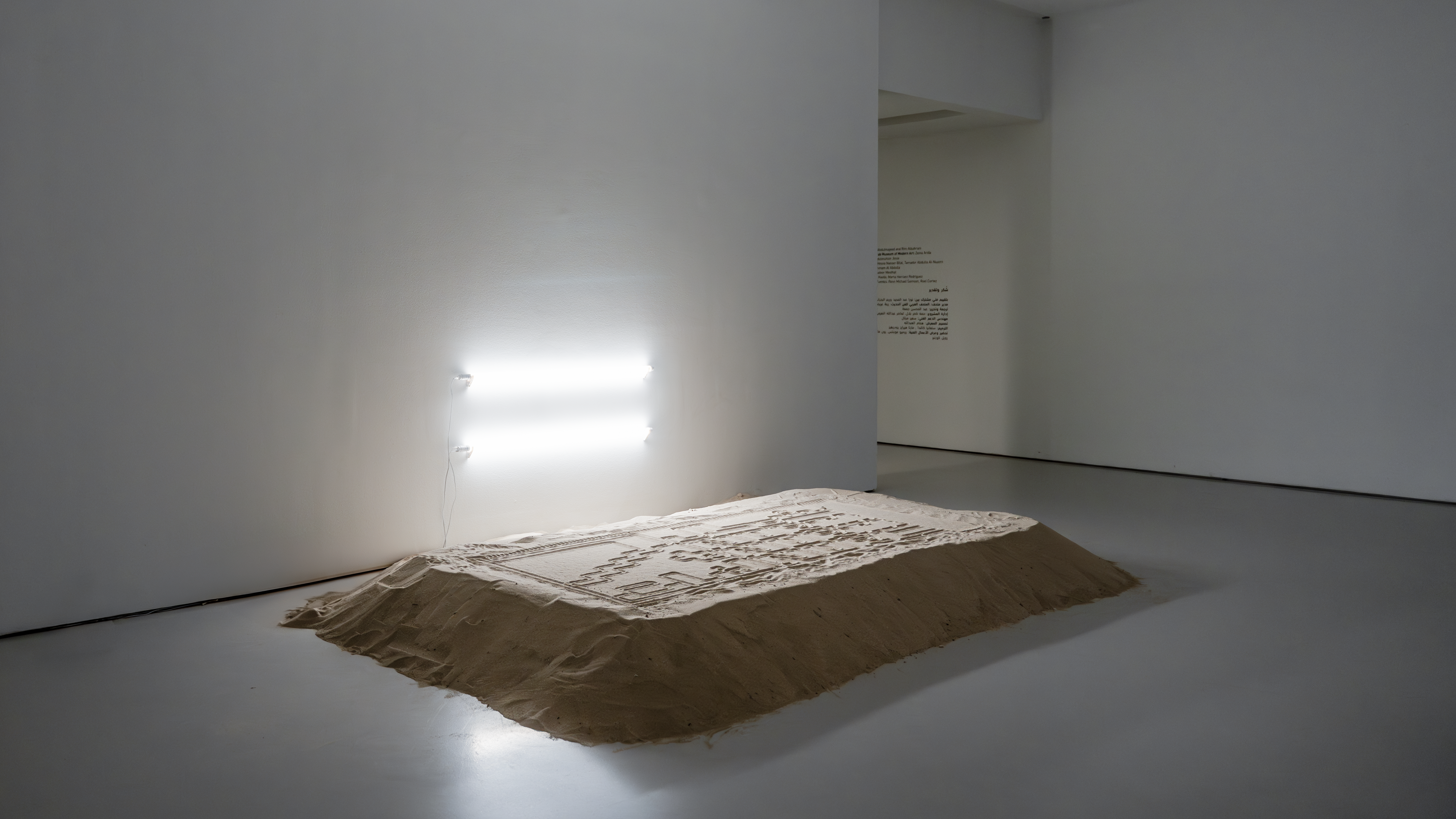
De/constructed Meanings showcases an installation developed by Hala Amer, Saga Elkabbash, Levi Hammett, Maryam Al Homaid, Giovanni Innella, & George Paul. Through the lens of this project space collaboration, the installation titled Future Memories is reimagined by co-curators Noora Abdulmajeed & Rim Albahrani to reflect upon the deconstruction theory of the philosopher Jacques Derrida (1930-2004).
This methodology focuses on the indefinite interpretations embedded within the examination of speech and writing that formulate language and meaning. Existing discourses relating to particular cultures and geographies play a central part in our perceptions of the truth. Dominant power structures, often manifested through binary oppositions, perpetuate hierarchical understandings of systems, influencing what is commonly perceived as True or false.
This methodology focuses on the indefinite interpretations embedded within the examination of speech and writing that formulate language and meaning. Existing discourses relating to particular cultures and geographies play a central part in our perceptions of the truth. Dominant power structures, often manifested through binary oppositions, perpetuate hierarchical understandings of systems, influencing what is commonly perceived as True or false.
Within the oppositional structures of either/or, the text reveals an alternative reading that reconstructs preconceived notions of meaning. With reference to the Derridean method, the installation acts as a machine materializing text as a mode of representation dependent on ideological influences. Using sand as a canvas to convey critical thought centered around the historical contexts of the past, present and future, the machine invites the viewer to observe their fixed and fluid nature. This exhibition unveils the evolution of linguistic systems, challenging inherited interpretations of oppositional notions as they are often understood.
Future Memories is an installation that acts as a writing device, using sand as a recording medium and a metal sphere as a writing tool. Computer numerical control renders precise motions of writing and erasing through a resistant landscape of sand, navigating the dynamics of human intention and natural forces, creating an earthen digital display. Through computational choreography, the display composes textual phrases through the critical lens of the Derridean deconstruction theory. By fusing technology and art, the machine invites the audience to engage with both the aesthetic and the philosophical, thereby exploring the complexity of meaning behind language, identity, and socio-cultural experiences.
The artwork was originally commissioned by The Gallery at VCUarts Qatar as part of the Language as Machine exhibition in 2023. The project is supported by xLab through the Institute for Creative Research at VCUarts Qatar.
Future Memories is an installation that acts as a writing device, using sand as a recording medium and a metal sphere as a writing tool. Computer numerical control renders precise motions of writing and erasing through a resistant landscape of sand, navigating the dynamics of human intention and natural forces, creating an earthen digital display. Through computational choreography, the display composes textual phrases through the critical lens of the Derridean deconstruction theory. By fusing technology and art, the machine invites the audience to engage with both the aesthetic and the philosophical, thereby exploring the complexity of meaning behind language, identity, and socio-cultural experiences.
The artwork was originally commissioned by The Gallery at VCUarts Qatar as part of the Language as Machine exhibition in 2023. The project is supported by xLab through the Institute for Creative Research at VCUarts Qatar.
Exhibitions & Publications:
Watering the Desert. YUZ Museum, Shanghai, China. (Group Exhibition, International). 8 November 2023 - 3 March 2024.
Deconstructed Meanings. Mathaf Arab Museum of Modern Art. (Solo Exhibition, National). 26 October 2023 - March 2024.
Language as Machine. The Gallery, Virginia Commonwealth University School of the Arts in Qatar, Doha, Qatar (Commissioned, Solo Exhibition, Local). 12 February - 8 April 2023.
Watering the Desert. YUZ Museum, Shanghai, China. (Group Exhibition, International). 8 November 2023 - 3 March 2024.
Deconstructed Meanings. Mathaf Arab Museum of Modern Art. (Solo Exhibition, National). 26 October 2023 - March 2024.
Language as Machine. The Gallery, Virginia Commonwealth University School of the Arts in Qatar, Doha, Qatar (Commissioned, Solo Exhibition, Local). 12 February - 8 April 2023.
Concept: Giovanni Innella, Hala Amer, & Saga Elkabbash.
Type Design: Maryam Al Homaid.
Writing: Giovanni Innella, Maryam Al Homaid, Noora Abdulmajeed, & Rim Albahrani.
Electronics & Programing: Levi Hammett & George Paul
Production: Levi Hammett, Hala Amer, & Saga Elkabbash.
Originally commissioned by: The Gallery @ VCUarts Qatar
Type Design: Maryam Al Homaid.
Writing: Giovanni Innella, Maryam Al Homaid, Noora Abdulmajeed, & Rim Albahrani.
Electronics & Programing: Levi Hammett & George Paul
Production: Levi Hammett, Hala Amer, & Saga Elkabbash.
Originally commissioned by: The Gallery @ VCUarts Qatar
Becoming
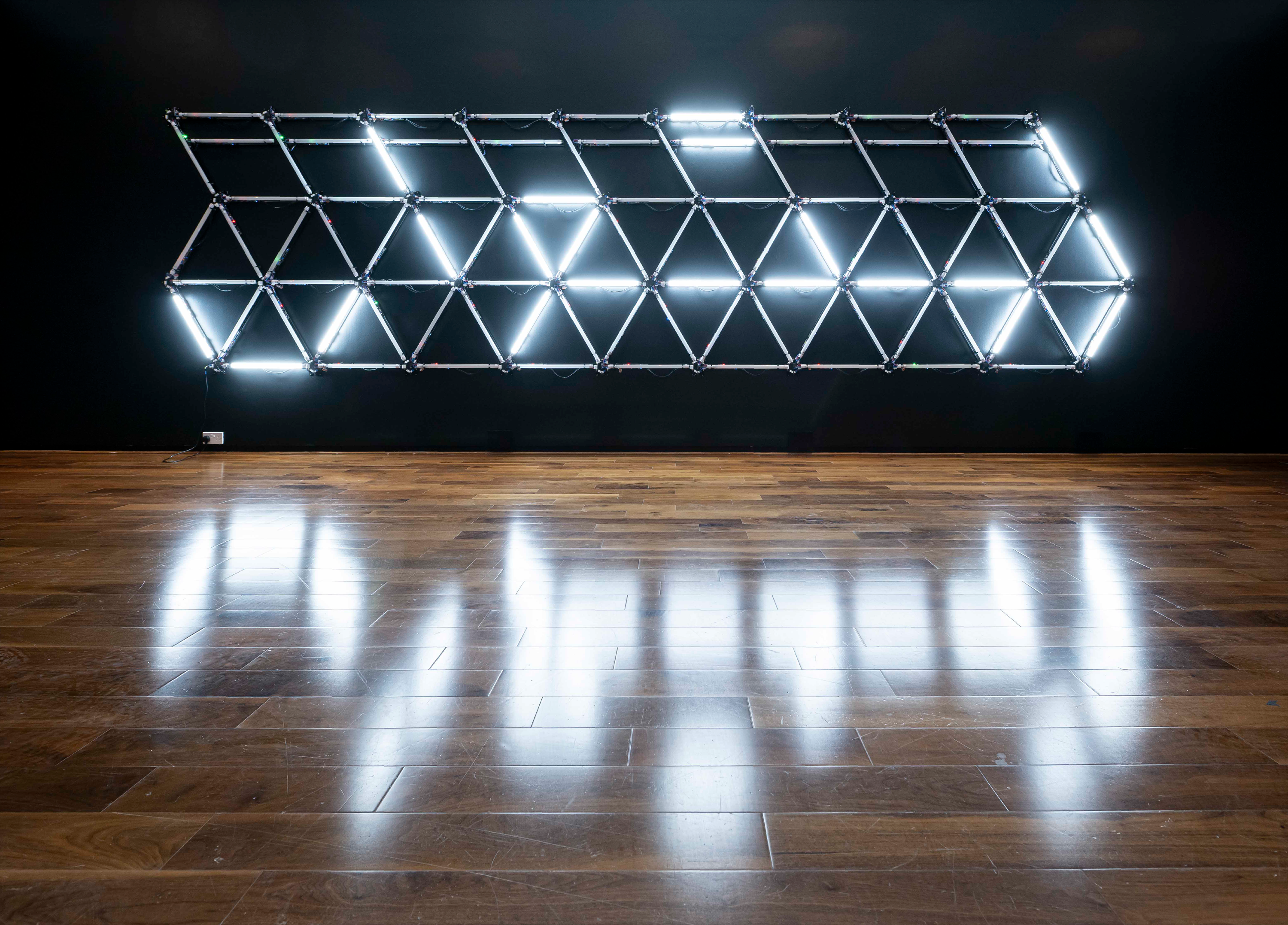
Becoming (استفعل) is the latest light installation in a body of work imagining alternative typographic histories by constructing unconventional language display technologies. Here, freed from structural conventions pressed by the dominance of Latin scripts, we celebrate the formal potential of the Arabic language.
Bright, bold, blinking verbs cycle through this hundred-segment display. These formalisms work heritage into the future, creating a catalyst toward alternative realities of becoming. Where these words are forces driving toward an unwritten landscape populated by unconventional technologies, in turn shaping new typographic structures.
Bright, bold, blinking verbs cycle through this hundred-segment display. These formalisms work heritage into the future, creating a catalyst toward alternative realities of becoming. Where these words are forces driving toward an unwritten landscape populated by unconventional technologies, in turn shaping new typographic structures.
The series of words takes us to the roots and connotations of verbs to be. Arabic Sarf (Arabic Morphology and Etymology) is the internal assembly of a word by way of patterns of vowelization and introduction of extra letters, which constitute a template. The template provides additional connotations “the bolder the template, the heavier the meaning”. As the title suggests, استفعل is a dynamic verb form of six letters, which means transitionally becoming, literally and figuratively, moving from one state to the other, and suggests deliberate and successive forms of the action.
Exhibitions & Publications:
Hammett, Levi., Hind Al Saad, & Mohammad Suleiman. Becoming. SIGGRAPH 2024, Denver, United States. (Group Exhibition, International). 28 July - 1 August 2024.
Hammett, Levi., Hind Al Saad, & Mohammad Suleiman. Becoming. Ars Electronica, Linz, Austria. (Group Exhibition, International). 6-10 November 2023.
Hammett, Levi., Hind Al Saad, & Fatima Abbas. Becoming. International Simposium on Electronic Art, Forum des images, Paris, France. (Group Exhibition). 16 - 23 May 2023.
Hammett, Levi., et al. Becoming. Language As Machine, The Gallery @ VCUarts Qatar, Doha, Qatar. (Solo Exhibition). 13 February 2023 - 9 April 2023.
Deezine. VCUarts Qatar presents nine installations informed by linguistics. 17 March 2023. (Article) link
Hammett, Levi., Fatima Abbas, Hind Al Saad, & Mohammad Suleiman. Alternative Typographic Histories: Arabic Script as a Driver of Language Display Technology. Acadia 2022: Hybrids & Haecceities, University of Pennsylvania, Philadelphia, United States. (Presentation, Proceedings). 28 October 2022.
Hammett, Levi., Hind Al Saad, & Mohammad Suleiman. Becoming. SIGGRAPH 2024, Denver, United States. (Group Exhibition, International). 28 July - 1 August 2024.
Hammett, Levi., Hind Al Saad, & Mohammad Suleiman. Becoming. Ars Electronica, Linz, Austria. (Group Exhibition, International). 6-10 November 2023.
Hammett, Levi., Hind Al Saad, & Fatima Abbas. Becoming. International Simposium on Electronic Art, Forum des images, Paris, France. (Group Exhibition). 16 - 23 May 2023.
Hammett, Levi., et al. Becoming. Language As Machine, The Gallery @ VCUarts Qatar, Doha, Qatar. (Solo Exhibition). 13 February 2023 - 9 April 2023.
Deezine. VCUarts Qatar presents nine installations informed by linguistics. 17 March 2023. (Article) link
Hammett, Levi., Fatima Abbas, Hind Al Saad, & Mohammad Suleiman. Alternative Typographic Histories: Arabic Script as a Driver of Language Display Technology. Acadia 2022: Hybrids & Haecceities, University of Pennsylvania, Philadelphia, United States. (Presentation, Proceedings). 28 October 2022.
Concept: Levi Hammett & Hind Al Saad.
Type Design: Hind Al Saad & Fatima Abbas.
Writing: Hind Al Saad & Sara Khalid.
Programing: Levi Hammett & Hind Al Saad.
Electronics: Levi Hammett
Production: Mohammad Suleiman & xLab
Commissioned by: The Gallery @ VCUarts Qatar
Type Design: Hind Al Saad & Fatima Abbas.
Writing: Hind Al Saad & Sara Khalid.
Programing: Levi Hammett & Hind Al Saad.
Electronics: Levi Hammett
Production: Mohammad Suleiman & xLab
Commissioned by: The Gallery @ VCUarts Qatar
Fragments of an Alternative Future
The evolution of typography has primarily been driven by technological innovation designed to meet new use-case scenarios. The 20th century saw an exponential increase in typographic diversity created to take advantage of new technologies and communication needs. The locality of these technological innovations were primarily situated in the english speaking west, and focused only on the latin script. The power of these innovations further marginalized and endangered languages using alternative scripts that were not in a position to adapt to the new technologies and domains of communication.
This project imagines an alternative future where arabic is a primary language and evolved together with the technological innovations of the 20th century. To explore this future, a number of typefaces were envisioned, designed, and produced utilizing technology that represents specific typographic domains. In this case a segmented LED typeface, as well as a dot matrix arabic typeface. Based on our research1,2,3, this is the first fully functioning segmented arabic typeface design ever produced (some patents were created in the 1980's but were not produced). The typeface was designed by Fatima Abbas, programmed by Levi Hammett and Hind Al Saad, and constructed by Levi Hammett.
Exhibitions & Publications:
Hammett, Levi., Ryan Browning, Fatima Abbas, & Hind Al Saad. xLab (Electronic LED display installation, paper print, single channel screen). Research Labs Exhibition. Qatar America Institute for Culture. Washington DC, USA. (Invited, Group Exhibition). 2 February - August 2023. link
Hammett, Levi., Fatima Abbas, Hind Al Saad, & Mohammad Suleiman. Alternative Typographic Histories: Arabic Script as a Driver of Language Display Technology. Acadia 2022: Hybrids & Haecceities, University of Pennsylvania, Philadelphia, United States. (Presentation, Proceedings). 28 October 2022.
Hammett, Levi., Ryan Browning, Fatima Abbas, & Hind Al Saad. xLab (Electronic LED display installation, paper print, single channel screen). Qatar Week Research Lab Exhibition, Anderson Gallery, Richmond, Virginia, USA. (Invited, Group Exhibition). 16 September 2022.
Hammett, Levi., Fatima Abbas, et al. Fragments of an Alternative Future. Hammett, Levi., & Fatima Abbas. Tasmeem Radical Futures exhibition, Tasmeem Doha 2022, VCUarts Qatar, Doha, Qatar. 7 March 2022 - April 2022.
Hammett, Levi., Fatima Abbas, et al. Fragments of an Alternative Future. Hello, World!, Doha, Qatar. (Juried, Solo Exhibition). November 2021 - February 2022.
Concept: Levi Hammett.
Type Design: Fatima Abbas.
Programing: Levi Hammett & Hind Al Saad.
Hammett, Levi., Ryan Browning, Fatima Abbas, & Hind Al Saad. xLab (Electronic LED display installation, paper print, single channel screen). Research Labs Exhibition. Qatar America Institute for Culture. Washington DC, USA. (Invited, Group Exhibition). 2 February - August 2023. link
Hammett, Levi., Fatima Abbas, Hind Al Saad, & Mohammad Suleiman. Alternative Typographic Histories: Arabic Script as a Driver of Language Display Technology. Acadia 2022: Hybrids & Haecceities, University of Pennsylvania, Philadelphia, United States. (Presentation, Proceedings). 28 October 2022.
Hammett, Levi., Ryan Browning, Fatima Abbas, & Hind Al Saad. xLab (Electronic LED display installation, paper print, single channel screen). Qatar Week Research Lab Exhibition, Anderson Gallery, Richmond, Virginia, USA. (Invited, Group Exhibition). 16 September 2022.
Hammett, Levi., Fatima Abbas, et al. Fragments of an Alternative Future. Hammett, Levi., & Fatima Abbas. Tasmeem Radical Futures exhibition, Tasmeem Doha 2022, VCUarts Qatar, Doha, Qatar. 7 March 2022 - April 2022.
Hammett, Levi., Fatima Abbas, et al. Fragments of an Alternative Future. Hello, World!, Doha, Qatar. (Juried, Solo Exhibition). November 2021 - February 2022.
Concept: Levi Hammett.
Type Design: Fatima Abbas.
Programing: Levi Hammett & Hind Al Saad.
Notes:
1. Md. Abul Kalam Azad., Rezwana Sharmeen., & S. M. Kamruzzaman. Universal Numeric Segmented Display. Proc. 7th International Conference on Computer and Information Technology (ICCIT-2004), Dhaka, Bangladesh, pp. 887-892, Dec. 2004. Link
2. Rahman, Mohammad Osiur., & Shafique, Mubashsharul., & Scavino, Edgar & Hussain, Aini & Basri, Hassan. The design of a complete uniform segmented display unit for Arabic alphanumeric characters.
1-7. 10.1109/ITSIM.2008.4631901. 2008. Link
3. Beg, M., & Ahmad, Wasim. Dot Matrix Alphanumeric Display System for Arabic. Consumer Electronics, IEEE Transactions on. CE-33.
47 - 50. 10.1109/TCE.1987.290216. 1987. Link
1. Md. Abul Kalam Azad., Rezwana Sharmeen., & S. M. Kamruzzaman. Universal Numeric Segmented Display. Proc. 7th International Conference on Computer and Information Technology (ICCIT-2004), Dhaka, Bangladesh, pp. 887-892, Dec. 2004. Link
2. Rahman, Mohammad Osiur., & Shafique, Mubashsharul., & Scavino, Edgar & Hussain, Aini & Basri, Hassan. The design of a complete uniform segmented display unit for Arabic alphanumeric characters.
1-7. 10.1109/ITSIM.2008.4631901. 2008. Link
3. Beg, M., & Ahmad, Wasim. Dot Matrix Alphanumeric Display System for Arabic. Consumer Electronics, IEEE Transactions on. CE-33.
47 - 50. 10.1109/TCE.1987.290216. 1987. Link
Construction City
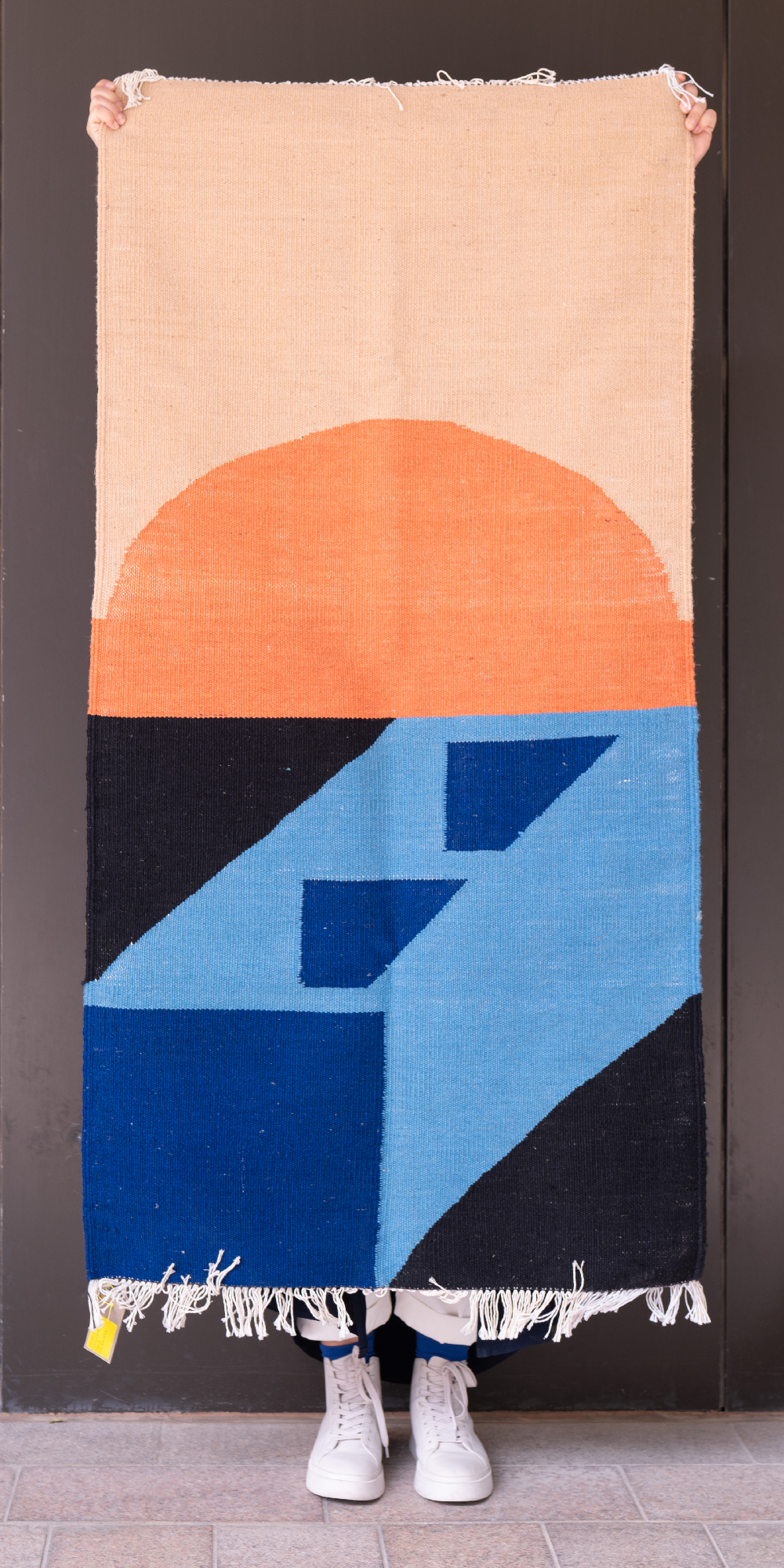
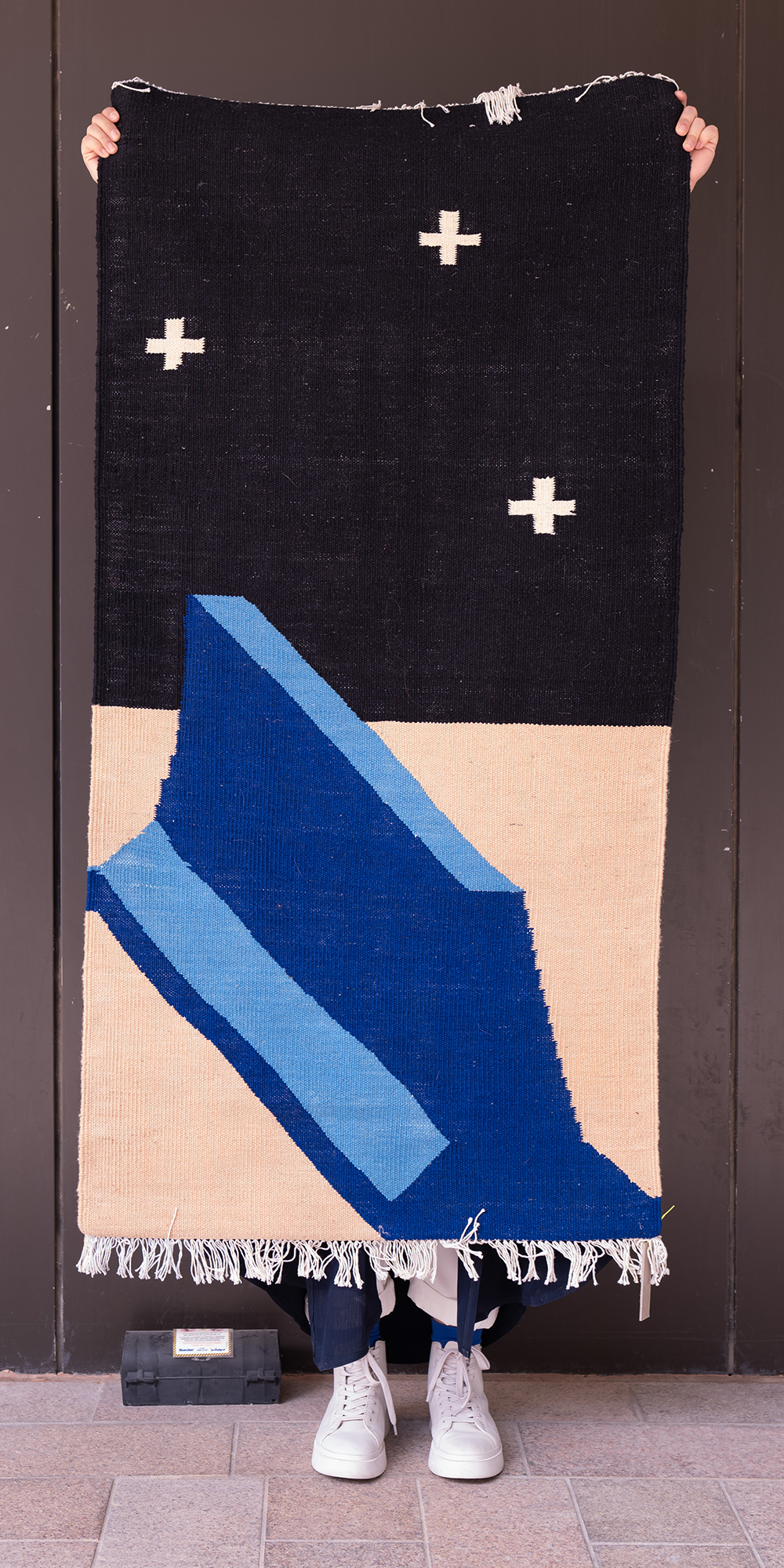
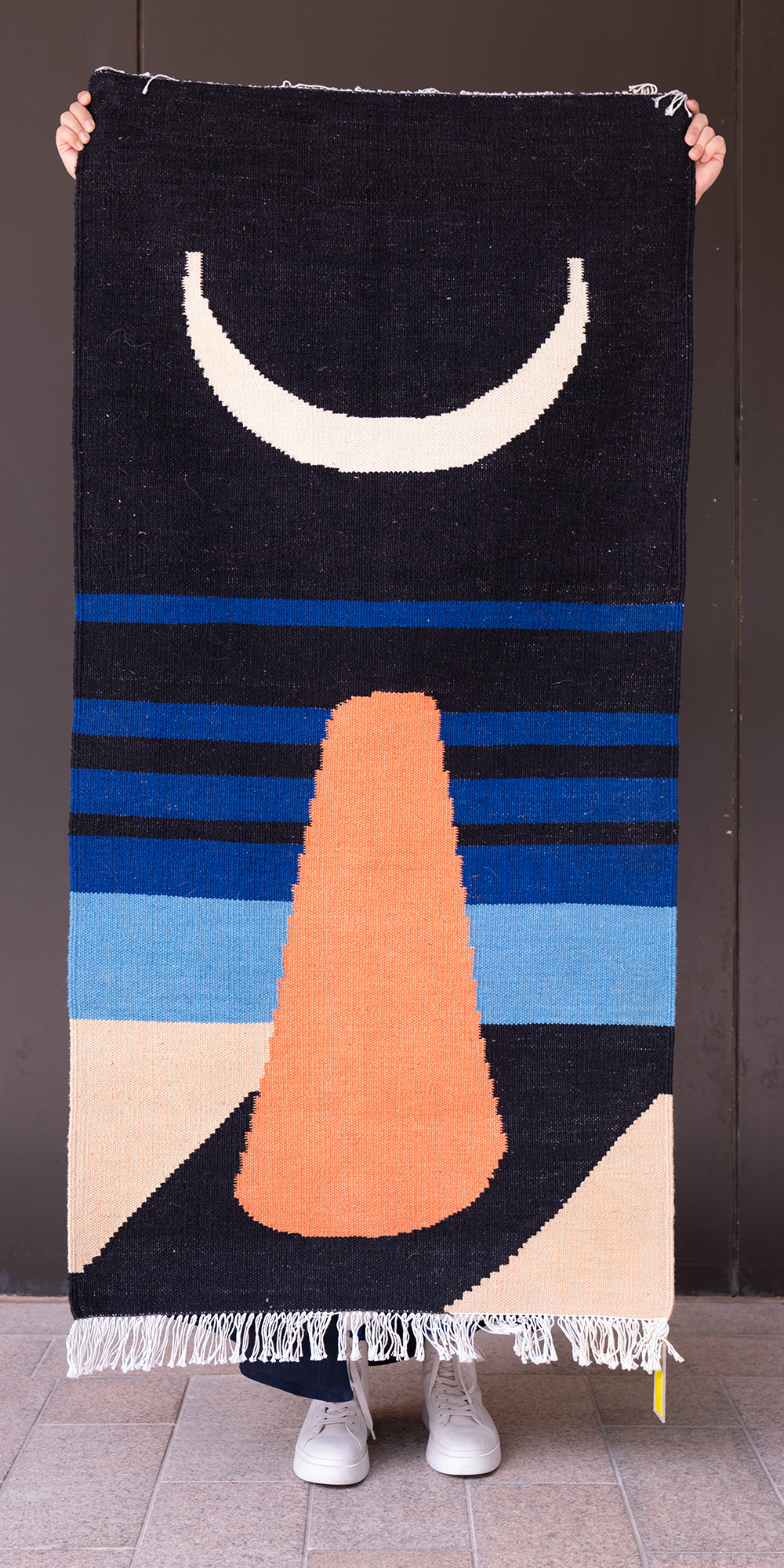
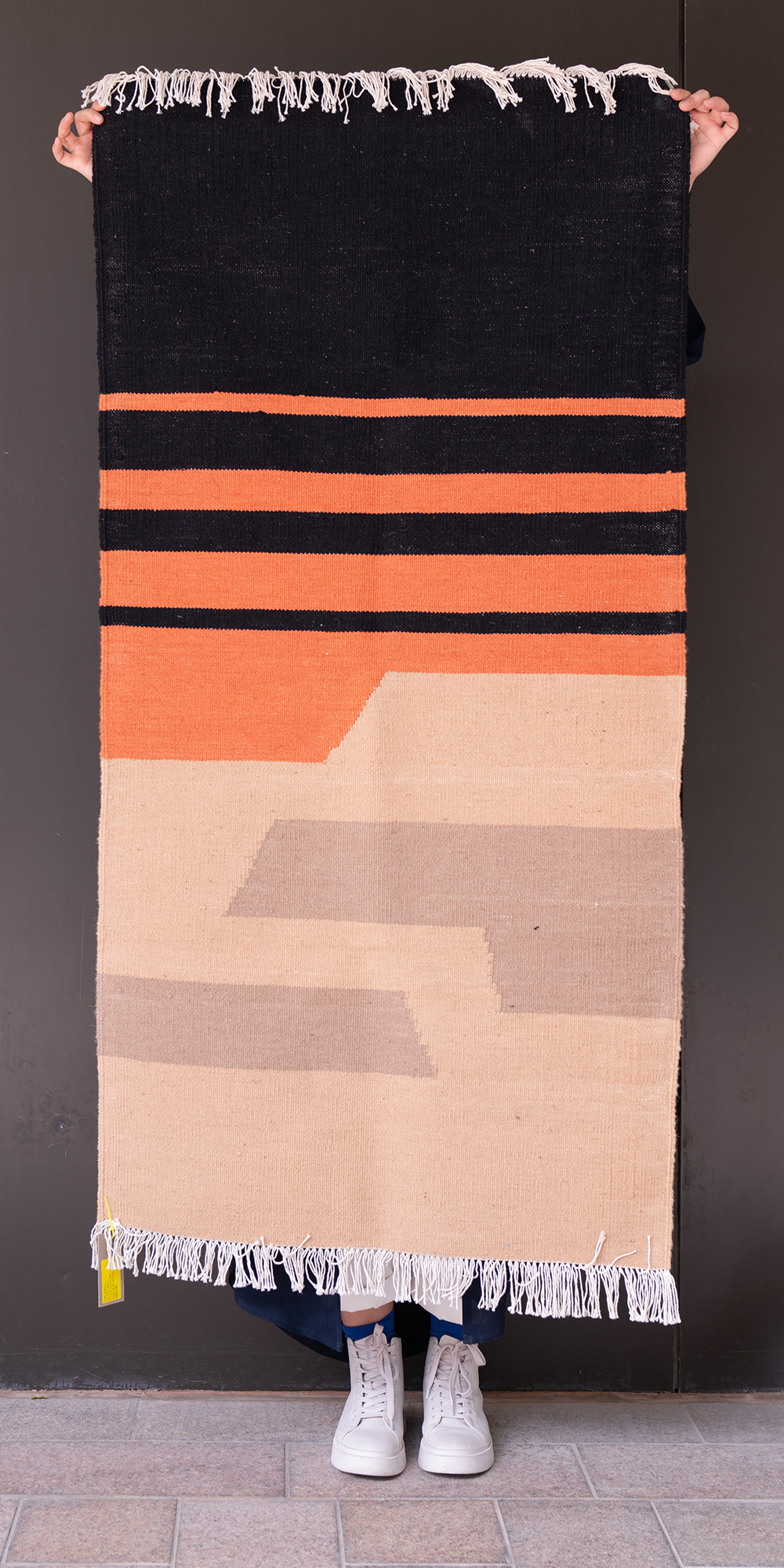
This edition of hand-made flat weave kilim rugs explores the perpetually changing landscape of Doha, framing the city as a place that is in constant reinvention. The process of construction is often viewed as a necessary nuisance, a disruption of the everyday working of the city. This body of work takes a different view, celebrating the sheer scale of Doha’s construction activities, and imagining an metropolitan identity that embraces this state of constant re-invention.
The motifs were developed by Levi Hammett and Maryam Al Homaid and explore both the mundane aspects of the construction city as well as the fabricated spaces and invented locations that continue to emerge as part of the urban landscape.
Hammett, Levi, & Maryam Al Homaid. Construction City. (Hand dyed wool, Hand woven). 2021.